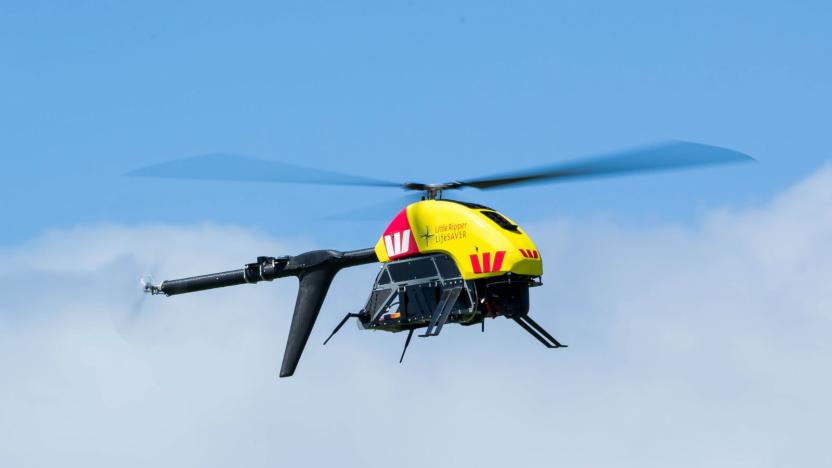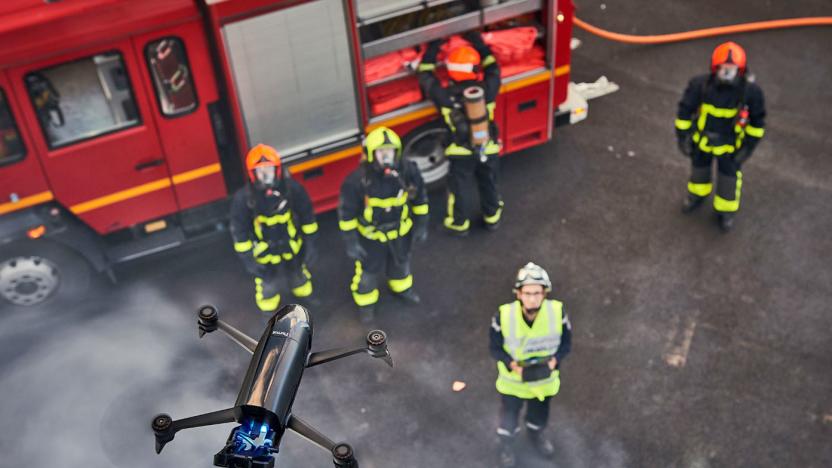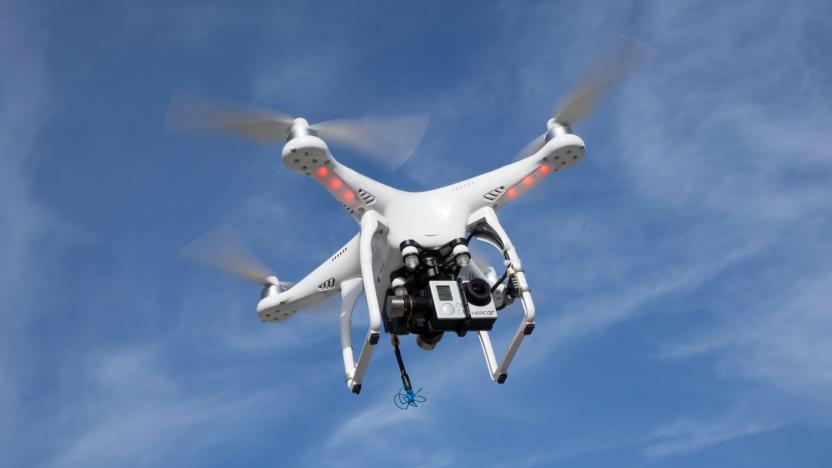SearchAndRescue
Latest

Lifeguard drone completes world-first ocean rescue
Australia's 'Little Ripper' drone has saved a pair of swimmers caught in rough seas in what's thought to be a world-first rescue operation. Lifeguards were busy testing the UAV off Lennox Head as part of New South Wales' $250,000 shark-spotting strategy when the distress call came in. Within 70 seconds the aerial helper had tracked down the stranded duo and dropped them a flotation pod, which they used to safely make their way to shore, according to The Sydney Morning Herald.

Parrot's latest drones are for farmers and firefighters
It's been a tough year for Parrot. The drone maker cut 290 jobs after sub-par sales, and it wasn't shy in admitting that its lineup was both unfocused and (for personal drones) unprofitable. However, it has an idea as to how to recover: by targeting the professional crowd. Its new Bebop-Pro Thermal and Bluegrass drones include equipment tailored to specific needs. The Bebop, as its name implies, includes a thermal imaging camera and matching software alongside the usual video cam. It's meant to help firefighters and rescue crews pinpoint sources of heat, whether it's a blaze or a person trapped under rubble. There's also a long-range remote control in the box to keep pilots well out of harm's way.

Drone flies as both biplane and helicopter using one propeller
There are helicopter drones and fixed-wing drones, but creating a hybrid of both is tricky. Even Parrot's Swing, as clever as it is, needs four propellers and elaborate wings to pull off its stunt. However, TU Delft (with backing from Parrot) has a far more elegant solution. Its DelftAcopter drone doubles as both a fixed-wing aircraft and a helicopter using only one propeller -- its tailless biplane design lets it take off and hover vertically, but gracefully turn into a fast-moving airplane (up to 62MPH) at a moment's notice. It's an incredibly simple design that makes you wonder why someone hadn't considered it for drones before.

DJI will supply drones for European emergency missions
While aerial drones are opening up a whole new world for consumers, organizations are also quietly working out the best way to deploy them in high-impact situations. The UAE's Drones for Good competition, for example, awarded $1 million to the makers of a rescue UAV that can search buildings, but drone maker DJI now wants to help set the rules for how and when they should be deployed. The company has teamed up with European Emergency Number Association (EENA) to create a set of best practices for response teams all over the globe.

Drone pilots sign up in droves to fly during emergencies
You may see a lot of stories about civilian drone operators causing chaos during emergencies, but it's clearer than ever that many of them are willing to help out, too. Bard College has published Federal Aviation Administration commercial drone exemption requests showing that a hefty 19 percent of requests from the last quarter of 2015 mentioned emergency services -- six times as many as reported several months earlier. In theory, that could lead to a lot of private pilots helping officials with search and rescue missions or other critical situations.

#ICYMI: NFC Cognac Caps, play a Virtual Neymar, and More
#fivemin-widget-blogsmith-image-361023{display:none;} .cke_show_borders #fivemin-widget-blogsmith-image-361023, #postcontentcontainer #fivemin-widget-blogsmith-image-361023{width:570px;display:block;} try{document.getElementById("fivemin-widget-blogsmith-image-361023").style.display="none";}catch(e){} Today on In Case You Missed It: Remy Martin installs NFC-enabled caps on its cognac bottles to prevent shady saloons from pulling the old switcheroo, Nike lets Google Cardboard users to play soccer as Neymar Jr., and a London-based artist creates custom Power Gloves that can carve through wood and stone. From the cutting room floor: This Auburn Fire Department quadcopter makes a special delivery of lifejackets and tow lines to a couple of guys stranded in the middle of a river. Let the team at Engadget know about any interesting stories or videos you stumble across by using the #ICYMI hashtag @engadget or @mskerryd.

Drone helps rescue trapped rafters
Drones aren't just useful as scouts and signalers during rescue operations -- they can play a hand in the actual rescue, too. When the Auburn Fire Department went to help recover two young men stranded in the middle of rapids in Mechanics Falls, Maine, Fire Chief Frank Roma used a DJI Phantom 3 to deliver a tag line that carried a much-needed life jacket. It also doubled as an observer while emergency crews sent an inflatable boat to bring the men back to shore, as you can see in the video below. While Roma notes that the Phantom 3 was his personal machine rather than official equipment, he's eager to see drones used more often in the field. This only "scratch[es] the surface," he tells TV network WMTW. It'll be a while before robots are carrying you out of danger, unfortunately, but that key role in a river rescue offers a glimpse of what's possible.

Tiny tethered drone gives soldiers a view of the dangers ahead
Drones already give troops valuable data about enemies and devastated areas, but the existing vehicles have their limits; big aerial drones can't see inside buildings, and their ground-based counterparts can't get over rough terrain. Well, CyPhy Works might just have reached a happy balance between those two extremes. It recently signed a deal with the US Air Force to produce the Extreme Access Pocket Flyer, a very tiny UAV (it weighs just 2.8oz) that sends HD video to soldiers for up to two hours. The key to its portability is a 250-foot microfilament tether that delivers both power and data -- bulkier gear like batteries will stay with the soldier. This has the upshot of adding reliability and security, since there's no wireless signal subject to interference or jamming.

Snakebot and quadcopter combo makes for a go-anywhere rescue drone
Everyone has different ideas on what the perfect search-and-rescue robot is, and for a University of Pennsylvania Mod Lab team, it comes in the form of a snake drone-quadcopter chimera. The Hybrid Exploration Robot for Air and Land Deployment or H.E.R.A.L.D. is composed of two snake-like machines that attach via magnets to a UAV. After being carried to the site by the quadcopter, the snake bots can detach themselves, slip through the holes and cracks of a collapsed building, for instance, and slither to their destination. The researchers have been working on H.E.R.A.L.D. since 2013, but now that all its components can properly merge and work together like the robots in Power Rangers, they presented it at the 2014 IEEE/RSJ International Conference on Intelligent Robots and Systems. You can watch the machine ace the tests its creators put it through in the vid after the break, including a part where a researcher used an Xbox controller to navigate a snakebot through a pipe.

These robots have x-ray vision, thanks to WiFi
These robots from the labs of a University of California, Santa Barbara professor might not be able to outrun anyone, but they sure have a special ability of they own: they can see through walls using only WiFi signals. For the technique to work, the machines work in pairs, with one broadcasting wireless transmissions and another (positioned on the opposite end) measuring them. Since walls and objects reduce signal strength, the receiver can distinguish between empty and occupied spaces to create an accurate map of the area. These aren't the first robots we've seen that can peer through concrete, but the Cougar20-H surveillance robot that emerged years ago uses a number of sensors, whereas UCSB's creation depends solely on WiFi.

JPL's RoboSimian flexes its robot muscles, haunts your nightmares (video)
Not content on landing several rovers on the surface of Mars, NASA's JPL team's been working on more earthly projects. RoboSimian is an ape-like robot designed for search-and-rescue missions that's expected to compete in the DARPA Robotics Challenge. It features four multi-jointed limbs with unique hands and no defined front or back -- allowing it to always face the right way. Thanks to its primate-like movement and posture, the robot will be able to navigate over difficult terrain, climb ladders and even drive vehicles (one of the DRC's requirements). While the project itself isn't new, JPL recently published an interesting video that shows RoboSimian gripping tools, lifting its own weight and balancing delicate objects. This means, of course, that robot monkeys will soon join spiders, cats and dogs in your dystopian nightmares. Video after the break.

AeroSee uses drones for mountain rescue, wants you to join the search
The woods may be lovely, dark and deep, but they're also dangerously unpredictable. That's why the University of Central Lancashire is looking to improve search and rescue technology with AeroSee, a project that incorporates drones to locate missing hikers. The lightweight aircraft, provided by E-Migs, are equipped with cameras that transmit video to nearby ground stations. Analysis is then crowd-sourced by search agents, who scour the images for missing persons, like a high-stakes Where's Waldo. And that's where you come in. Tomorrow, July 25th at 12:30PM GMT (7:30AM ET), UCLan will launch a simulated mission where you can log in to its site to scour images for a survivor. The fastest virtual savior will top the leader board and take home a sweet prize. Want to sign up for the search? Head on over to the source link below.

Robot jellyfish feeds on its surroundings, looks for a job in underwater surveillance
We've seen plenty of robots inspired by nature, but this robot jellyfish developed by researchers from University of Texas at Dallas and Virginia Tech goes one big step beyond mimicking a jellyfish's movements. It's powered by hydrogen, which means that it could potentially stay underwater for prolonged periods of time and constantly refuel itself from the water around it. That, the researchers say, could make it ideal for underwater surveillance or search and rescue operations, but they still have a fair bit of work to do before that happens -- their next step is to increase its maneuverability. Head on past the break to check it out in its current state.

Eurocopter X3 hybrid sets new speed record of 430km/h, readies for next search and rescue mission
See that chopper right there? That's the Eurocopter X3, and as of last week, it can cruise at more than half the speed of a commercial jet. Although the helicopter was striving to hit 220 knots, it actually blew past that milestone to maintain 232 knots (450 km or 279.6 miles per hour) in level, stabilized flight -- a new record for this aircraft. For the uninitiated, the X3 earns its "hybrid" moniker by combining two turboshaft engines that power five-blade main rotor system and two propellers installed on short-span fixed wings -- which, in layman's terms, allows it to hover like a helicopter should while reaching the kind of speeds you'd expect from a turboprop-powered aircraft. (And before you get too excited, yes, this one requires pilots.) While we love the idea of a high-speed joy ride for tourists, this thing will be used for long-distance search and rescue missions, along with border patrol, coast guard duties, offshore operations, passenger and troop transport, and medical evacuation. So no ride for you, but you can get your vicarious thrill anyway with a short, percussion-heavy video after the break.

Sand-swimming robot gets vertical manipulation via doorstop-shaped head (video)
So it looks like a half-stuffed sock -- and it is, sort of -- but this sandfish-inspired search and rescue robot has the potential to change the way machines maneuver through disaster zones. Playing off its previous endeavors, a team of Georgia Tech researchers has designed a wedge-shaped head to manipulate the vertical movement of its sand-swimming invention through "complex dirt and rubble environments." By mimicking the pointy snout of the sandfish lizard, and attaching it to the body of its robot -- which sports seven servo-powered segments stuffed in a latex sock and sheathed by a spandex "swimsuit" -- the team found that subtle changes in the positioning of the robot's head made for drastic differences in vertical movement. When it was placed flat on the horizontal plane, the robot descended; when it was inclined above seven degrees, it ascended. For now, the robotic sandfish has been relegated to swimming in a sea of tiny yellow balls, but it's slated to dive into a pool of debris in the name of research soon. You can check out a rather dry description of the project in the video after the break.

SARbot searches for victims underwater in Japan (video)
Joining the extended family of robots assisting with the relief effort in Japan, the Texas-based Center for Robot-Assisted Search and Rescue (CRASAR) has sent its SARbot to Rikuzentakata. Like some of the other bots, this guy can shoot video as it swims under houses and other crippled structures, but it also sports a "limb grasping mechanism," designed to retrieve drowning victims and assist in other search and rescue operations. As of yet the machine's searches have come up empty, but the bot has kept the camera rolling during it's underwater adventures, so head past the break to check out a clip of its footage.

iRobot, QinetiQ machines to assist in Japan relief effort
A few weeks ago, it looked like robots would play a relatively small role in recovery efforts following the earthquake and subsequent nuclear crisis in Japan, but as concern grows over radiation leaks, robotics companies are positioning their mechanical offspring to do jobs deemed unsafe for humans. We've already heard of Aldebaran's plans for a fleet of rescue bots, and now QinetiQ and iRobot are lending automated assistance to the cause. QinetiQ plans to send in a set of Robotic Applique Kits -- used to convert Bobcat loaders into unmanned vehicles -- along with sensor machines like the TALON and Dragon. Meanwhile, iRobot's enlisted two each of its PackBots and Warriors to help aid in recovery -- the former is used by the US military for bomb disposal. Both companies have already deployed teams to Japan for training.

iMobot creeps, crawls, cranes its way into our hearts (video)
It may not look like much, but this little modular robot's got the stuff to give Keepon a run for its money -- oh yeah, and according to its creators, iMobot's got big implications for the field of robotics too. Sporting four degrees of freedom, two rotating joints, and a pair of faceplates that act as wheels, the patent-pending device can crawl, drive, and potentially act as an autonomous camera platform. The surprisingly agile hunk of machinery was developed by two UC Davis professors who say their versatile invention could aid in search and rescue, as well as education and research. We think it's super cool that iMobot could be a hero, but really, we just want to see it bust a move. Check out a video of our new robo love after the break.

Raytheon Controlled Impact Rescue Tool pulverizes concrete to save the day
Sure, we've got devices that can see through concrete walls, but why get all complicated when there's some good ol' fashioned bashing to be done? That's the poetic question posed by the Controlled Impact Rescue Tool, developed by Raytheon as part of a Department of Homeland Security program. The 100-pound rescue device uses specially-designed ammunition to create shock waves that can shatter through concrete walls in just 13 minutes, compared to nearly half an hour for conventional methods. Although the rig can create a hole big enough for a person to crawl out of, it's designed to be held up and operated by just two people, and as the video below shows, it doesn't look like it's too much of a bear to handle. Raytheon hasn't set a price for the CIRT yet, but it's aiming it at fire departments, rescue services and the military -- but we're always ready for a demo if anyone's interested.










